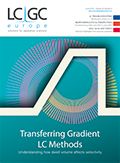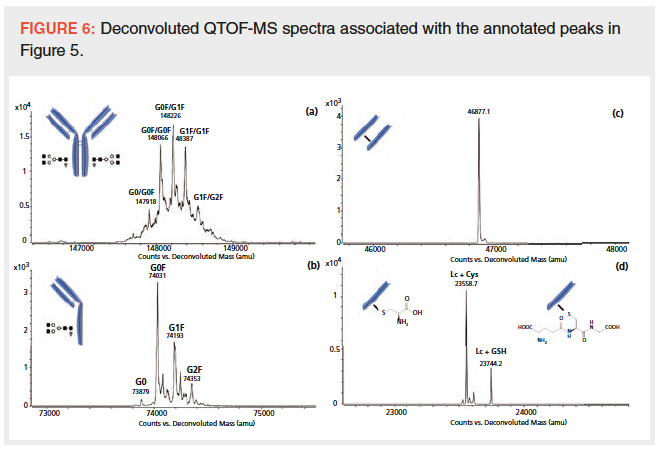Multidimensional Liquid Chromatography Approaches for Characterization of Protein Biopharmaceuticals
Davy Guillarme previews his presentation at HPLC 2019 highlighting the new trends in LC×LC applied for biopharmaceutical characterization, including the hyphenation with high‑resolution mass spectrometry (HRMS) and ion mobility spectrometry (IMS).
At the previous HPLC 2018 symposium, there was a strong focus on the analytical characterization of protein biopharmaceuticals, including monoclonal antibodies (mAbs) and antibody–drug conjugates (ADCs). In particular, there was an opening plenary lecture from Stacey Ma (Genentech, San Francisco, California, USA) about the most recent analytical technologies used in the biopharmaceutical industry. Additionally, there were also several dedicated lectures and posters sessions on the analysis of mAbs, ADCs, and other formats of proteinâbased drugs.
Since the development of recombinant insulin in 1982, the number of proteinâbased drugs has dramatically increased, and protein biopharmaceuticals have emerged as important therapeutic options for the treatment of cancer, inflammatory and autoimmune disorders, Alzheimer’s disease, and even migraines. Based on this broad range of applications, numerous pharmaceutical companies are increasing their efforts aimed at the research and product development of biologics. Given their obvious benefits in terms of safety and efficacy, mAbs are today the most successful biopharmaceutical products and have totally reshaped the pharmaceutical market (1). As well as mAbs, there is also strong interest in mAb-related products, such as new ADC formats, fusion proteins, PEGylated proteins, bispecific antibodies (BsAbs), antibody fragments (nanobodies and Fab), and polyclonal antibodies (pAb). Last, but not least, some of the first-generation mAbs and fusion proteins will come off patent soon, and there is consequently a significant increase of biosimilars activity requiring powerful analytical methods for comparability assessment of originators and biosimilars.
It is indeed important to keep in mind that these products are highly complex in terms of structure, and the characterization of therapeutic mAbs and ADCs is a tremendous challenge to stateâofâthe-art analytical technologies. Indeed, subtle changes in these large (greater than 150 kDa) molecules can have profound effects on efficacy, pharmacokinetic properties, and toxicity. It is therefore important to have the ability to rapidly and accurately assess changes in the distribution of different isoforms, for example, glycosylation, oxidation, deamidation, lysine truncation of these biomolecules (2).
Today, the most widely used analytical approaches for therapeutic protein characterization are liquid chromatography (LC) and mass spectrometry (MS), probably as a result of the remarkable developments of these strategies in the past few years, which have enabled a new level of performance. Lectures and posters at HPLC 2019 will demonstrate the usefulness of modern LC and MS approaches to demonstrate the product quality and increase the safety of biopharmaceutical products.
As well as the conventional LC modes, such as size-exclusion chromatography (SEC), ion exchange chromatography (IEC), hydrophobic interaction chromatography (HIC), reversedâphase LC, and hydrophilic interaction liquid chromatography (HILIC), it is also possible to combine the most promising chromatographic strategies in a comprehensive two-dimensional liquid chromatography (LC×LC) setup. This allows for a more detailed characterization of some highly complex and heterogeneous new biological entities, thanks to a significantly better peak capacity. In addition, LC×LC also offers the opportunity to combine nondenaturing chromatographic modes requiring significant amount of nonvolatile salts (IEC and SEC) to MS, using a desalting step in the second dimension. Even though LC×LC is becoming more and more popular for the analysis of small molecules, it has only very recently been used for biopharmaceutical characterization (3,4).
During my presentation at the next HPLC 2019 symposium, I will try to highlight the new trends in LC×LC applied for biopharmaceutical characterization, including the hyphenation with highâresolution mass spectrometry (HRMS) and ion mobility spectrometry (IMS).
References
- W.R. Strohl, Protein Cell9, 86–120 (2018).
- S. Fekete, D. Guillarme, P. Sandra, and K. Sandra, Anal. Chem.88, 480–507 (2016).
- A. Ehkirch, V. D’Atri, F. Rouviere, O. HernandezâAlba, A. Goyon, O. Colas, M. Sarrut, A. Beck, D. Guillarme, S. Heinisch, and S. Cianferani, Anal. Chem. 90, 1578–1586 (2018).
- M. Sorensen, D.C. Harmes, D.R. Stoll, G.O. Staples, S. Fekete, D. Guillarme, and A. Beck, mAbs8, 1224–1234 (2016).

Davy Guillarme holds a Ph.D. degree in analytical chemistry from the University of Lyon, France. He is now senior lecturer at the University of Geneva in Switzerland. He has authored more than 200 journal articles related to pharmaceutical analysis. His expertise includes HPLC, UHPLC, HILIC, LC−MS, SFC, and the analysis of proteins and mAbs. He is an associate editor of Journal of Chromatography B and editorial advisory board member of several journals.

Determining Enhanced Sensitivity to Odors due to Anxiety-Associated Chemosignals with GC
May 8th 2025Based on their hypothesis that smelling anxiety chemosignals can, like visual anxiety induction, lead to an increase in odor sensitivity, a joint study between the University of Erlangen-Nuremberg (Erlangen, Germany) and the Fraunhofer Institute for Process Engineering and Packaging (Freising, Germany) combined behavioral experiments, odor profile analysis by a trained panel, and instrumental analysis of odorants (gas chromatography-olfactometry) and volatiles (gas chromatography-mass spectrometry).
Investigating 3D-Printable Stationary Phases in Liquid Chromatography
May 7th 20253D printing technology has potential in chromatography, but a major challenge is developing materials with both high porosity and robust mechanical properties. Recently, scientists compared the separation performances of eight different 3D printable stationary phases.
Detecting Hyper-Fast Chromatographic Peaks Using Ion Mobility Spectrometry
May 6th 2025Ion mobility spectrometers can detect trace compounds quickly, though they can face various issues with detecting certain peaks. University of Hannover scientists created a new system for resolving hyper-fast gas chromatography (GC) peaks.

.png&w=3840&q=75)

.png&w=3840&q=75)



.png&w=3840&q=75)



.png&w=3840&q=75)














